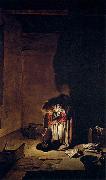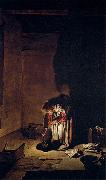Wholesale Oil Painting Reproductions No Minimum and Door to Door! |
|||||||||||
|
|
|||||||||||

|
|||||||||||
|
|
|
||||||||
All Domenico Fetti Oil Paintings |
||||||||
|
|
||||||||
|
|
||||||||
|
Artist Introduction: Italian painter ,
Rome 1589 - Venice 1623
was an Italian Baroque painter active mainly in Rome, Mantua and Venice. Born in Rome to a little-known painter, Pietro Fetti, Domenico is said to have apprenticed initially under Ludovico Cigoli, or his pupil Andrea Commodi in Rome from circa 1604-1613. He then worked in Mantua from 1613 to 1622, patronized by the Cardinal, later Duke Ferdinando I Gonzaga. In the Ducal Palace, he painted the Miracle of the Loaves and Fishes. The series of representations of New Testament parables he carried out for his patron's studiolo gave rise to a popular specialty, and he and his studio often repeated his compositions. In August or September 1622, his feuds with some prominent Mantuans led him to move to Venice, which for the first few decades of the seventeenth century had persisted in sponsoring Mannerist styles (epitomized by Palma the Younger and the successors of Tintoretto and Veronese). Into this mix, in the 1620s?C30s, three "foreigners"??Fetti and his younger contemporaries Bernardo Strozzi and Jan Lys??breathed the first influences of Roman Baroque style. They adapted some of the rich coloration of Venice but adapted it to Caravaggio-influenced realism and monumentality. In Venice where he remained despite pleas from the Duke to return to Mantua, Fetti changed his style: his formalised painting style became more painterly and colourful. |
||||||||
|
|
||||||||
|
Parable of the Lost Drachma Painting ID:: 84610 |
Date ca. 1618(1618)
Medium Oil on wood
Dimensions Height: 75 cm (29.5 in). Width: 44 cm (17.3 in).
cjr |
|||||||
Height Width |
INS/CM Quality |
|||||||
|
X |
| |||||||
|
|
||||||||
All Domenico Fetti Oil Paintings |
||||||||
|
|
||||||||
|
|
||||||||
|
Artist Introduction: Italian painter ,
Rome 1589 - Venice 1623
was an Italian Baroque painter active mainly in Rome, Mantua and Venice. Born in Rome to a little-known painter, Pietro Fetti, Domenico is said to have apprenticed initially under Ludovico Cigoli, or his pupil Andrea Commodi in Rome from circa 1604-1613. He then worked in Mantua from 1613 to 1622, patronized by the Cardinal, later Duke Ferdinando I Gonzaga. In the Ducal Palace, he painted the Miracle of the Loaves and Fishes. The series of representations of New Testament parables he carried out for his patron's studiolo gave rise to a popular specialty, and he and his studio often repeated his compositions. In August or September 1622, his feuds with some prominent Mantuans led him to move to Venice, which for the first few decades of the seventeenth century had persisted in sponsoring Mannerist styles (epitomized by Palma the Younger and the successors of Tintoretto and Veronese). Into this mix, in the 1620s?C30s, three "foreigners"??Fetti and his younger contemporaries Bernardo Strozzi and Jan Lys??breathed the first influences of Roman Baroque style. They adapted some of the rich coloration of Venice but adapted it to Caravaggio-influenced realism and monumentality. In Venice where he remained despite pleas from the Duke to return to Mantua, Fetti changed his style: his formalised painting style became more painterly and colourful. |
||||||||
|
|
||||||||
|
|
Parable of the Lost Drachma Painting ID:: 88459 |
1618(1618)
Medium Oil on wood
cyf |
||||||
Height Width |
INS/CM Quality |
|||||||
|
X |
| |||||||
|
|
||||||||
|
Prev Next
|
||||||||
|
|
||||||||
|
Related Paintings to Domenico Fetti :. |
||||||||
|
|
||||||||
|
CONTACT US |


